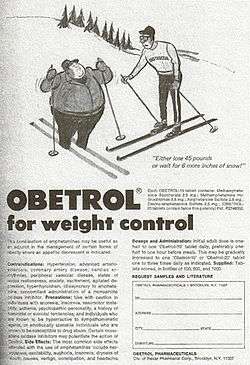Obetrol
 | |
| Combination of | |
|---|---|
| Dextroamphetamine | Psychostimulant |
| Amphetamine | Psychostimulant |
| Methamphetamine | Psychostimulant |
| Clinical data | |
| Pregnancy category |
|
| Dependence liability | High |
| Routes of administration | Oral |
| Legal status | |
| Legal status |
|
| ChemSpider | none |
| | |
Obetrol was the brand of amphetamine mixed salts based drugs indicated for treatment of exogenous obesity by the American pharmaceutical company Obetrol Pharmaceuticals. Obetrol was a popular diet pill in America in the 1950s and 1960s.[1]
A formulation of amphetamine mixed salts that included methamphetamine was approved by the U.S. Food and Drug Administration (FDA) on January 19, 1960 under the name Obetrol.[2] Between 1965 and 1973, this formula was offered in 10 mg and 20 mg strength through Obetrol Pharmaceuticals division of an American pharmaceutical company Rexar under the trade name Obetrol. Its indication was for exogenous obesity.[3]
Formulations
Original
In the 1950s, Obetrol was manufactured by Obetrol Pharmaceuticals, in Brooklyn, New York. The company later became a division of Rexar Pharmacal Corporation, which was also headquartered in Brooklyn. Sometime prior to 1972, Rexar Pharmacal moved its manufacturing facilities, including its Obetrol Pharmaceutical Division, to Valley Stream, New York. By the 1990s, Obetrol Pharmaceuticals had been wholly absorbed by Rexar Pharmacal and was no longer noted as a "division" of Rexar. In 1993, Rexar was acquired by Richwood Pharmaceuticals of Florence, Kentucky, which in 1995 merged with Shire Pharmaceuticals.
Per the 1972 Physicians' Desk Reference, Obetrol contained (per 10 mg tablet):
- 2.5 mg methamphetamine saccharate
- 2.5 mg methamphetamine hydrochloride
- 2.5 mg racemic amphetamine sulfate
- 2.5 mg dextroamphetamine sulfate
Obetrol was also available in 20 mg. tablets which contained twice the quantity of its ingredients, in the same proportions. The 10 mg. tablets were blue, and the 20 mg were orange. Both were inscribed with the letters, "OP".
Obetrol was withdrawn from the market in 1973 under DESI statute.[4]
Modified
Rexar reformulated Obetrol to exclude methamphetamine and continued to sell this new formulation under the same Obetrol brand name. This new unapproved formulation was later rebranded and sold as Adderall by Richwood after it acquired Rexar resulting in FDA warning in 1994. Richwood submitted this formulation as NDA 11-522 and Adderall gained FDA approval for the treatment of attention-deficit/hyperactivity disorder therapy on February 13, 1996.[4]
By the 1980s, the use of amphetamines—particularly methamphetamine—as an adjunct to diet and exercise in the treatment of exogenous obesity had become frowned upon by many in the medical community. As the decades evolved, so did the composition of Obetrol. By 1995, the year Shire Pharmaceuticals (then known as Shire-Richwood) acquired Rexar Pharmacal, Obetrol 10 mg. and 20 mg. tablets contained, (in equal proportions):
- Dextroamphetamine sulfate
- Dextroamphetamine saccharine
- Amphetamine sulfate
- Amphetamine aspartate
These tablets were also blue and orange, but were inscribed with the letters, "OB".
When Richwood acquired Rexar, the drug's name was changed from Obetrol to Adderall, and the drug was marketed for use in the treatment of Attention Deficit Disorder (in both children and adults). The old Rexar facility underwent extensive renovations and improvements, and continued to manufacture the drug for several years. During these years, the drug Adderall was identical to the most recent formulation of Obetrol, except that the inscription on the pills was changed to "AD".
Sometime after 2000, Shire closed the Rexar manufacturing facility and outsourced the manufacturing of "brand name" Adderall to a vendor in North Carolina. In fact, no Shire manufacturing facility (other than the Rexar facility it had acquired) produced immediate-release Adderall at any time. Other companies had begun manufacturing generic versions of Adderall, and the trade name was eventually sold to Barr Pharmaceuticals (acquired by Teva in 2008).
There is no drug commercially marketed called Obetrol at this time, nor has there been since Richwood acquired Rexar Pharmacal.
Abuse
The ready availability of methamphetamine-based medications in the 1960s led to their use and abuse as recreational drugs. Obetrol was the recreational drug of choice for artist Andy Warhol.[5] Obetrol was abused by a character named Chris Fogle in David Foster Wallace's novel The Pale King.[6] Obetrolling or doubling was the process by which the character referred to tripping on Obetrol, because it increased his self-awareness and made him feel alive.[7]
References
- ↑ Rasmussen, Nicolas, On speed : the many lives of amphetamine, New York University Press, (New York), 2008, pp.148, fig.33.
- ↑ "Adverse events reported with immediate-release mixed amphetamine salt products" (PDF). Center for Drug Evaluation and Research (CDER) – United States Food and Drug Administration (FDA). 2006-02-01. Retrieved 2013-05-20.
- ↑ Physicians' Desk Reference (20 ed.). Medical Economics. 1966. p. 811.; Physicians' Desk Reference (25 ed.). Medical Economics. 1973. p. 1027.
- 1 2 "REGULATORY NEWS: Richwood's Adderall". Health News Daily. 22 Feb 1996. Retrieved 29 May 2013.
- ↑ Bockris, Victor (1990). Warhol. Penguin.
- ↑ The Pale King, David Foster Wallace, Penguin Adult, 2011, chapter 22 or subsection 22 ISBN 0241144809, 9780241144800
- ↑ Wallace, David Foster (2011-04-15). The Pale King (p. 180). Little, Brown and Company. Kindle Edition.